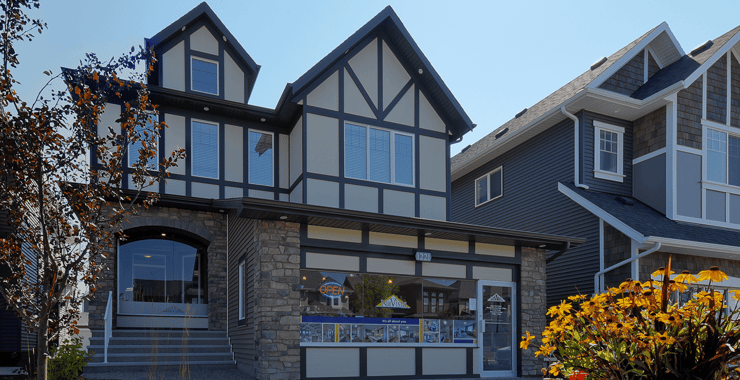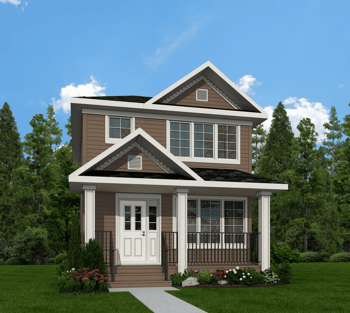 When you start shopping for a new house, you're going to encounter a lot of industry-specific terms that can be quite confusing. For example, builders refer to a house having an "exterior elevation," which sounds like it refers to how tall it is or high the roof might be, but this term actually means something different.
When you start shopping for a new house, you're going to encounter a lot of industry-specific terms that can be quite confusing. For example, builders refer to a house having an "exterior elevation," which sounds like it refers to how tall it is or high the roof might be, but this term actually means something different.
In simple words, a house's elevation is just the way it looks from the outside. Another way to think about it is that the "elevation" is the style in which the exterior of the house was built. The shapes, sizes, and materials used for your home's exterior affect the overall look.
 Of course, the exterior of the house also affects the way you'll live in the home. Different roof types provide different amounts of space, and the design and placement of the windows also make a big difference as well.
Of course, the exterior of the house also affects the way you'll live in the home. Different roof types provide different amounts of space, and the design and placement of the windows also make a big difference as well.
Building with NuVista homes means you'll have a variety of styles to choose from. In order to help you better understand your home elevation options, we've provided this brief tutorial.
Glossary
Pitch - This refers to the angle or the steepness of a roof. A "low" pitch means that the angle is not very steep while a "high" pitch refers to a steeper angle.
Hip roof - The term "hip" refers to interior rafters that aren't visible. A hip roof, when seen from above, looks like the top of a tent. The roof angles down towards the walls, and there are no "interruptions" or flat portions. If you were standing on the top of a hip roof and dropped a tennis ball, it would roll straight down to the gutters.
A "half hip" roof refers to a hip roof with multiple planes, generally used to accommodate gables or other architectural elements.
Stacked roof - The roof has multiple overhangs to make it look as though there are many roofs "stacked" on top of one another.
Gables - A gable is a triangular shaped extension of an exterior wall that "pokes out" from the roof. Gables are always flat vertically but may or may not be aligned with the exterior walls.
Dormer - When a window "pokes out" from the exterior wall or roof. This can be decorative or functional, adding natural light to the interior. Most dormers are combined with a gable.
Overhang - The section(s) of the roof that extends beyond the exterior wall. Overhangs provide shading for the home as well as help prevent rainwater from flowing down the outside walls.
Eaves - The eaves are the edges of the roof that form the overhang. In some architectural styles, the eaves may be decorated.
Rafter - These refer to the wooden beams that help hold up the roof. In some architectural styles, the rafters are "exposed" and remain visible after the home is built.
Shakes - When applying it to a house's elevation, this generally refers to a kind of siding and/or roof shingling that uses either real strips of wood or something that looks like it's made from strips of wood.
Battens - This term refers to anything that's a strip of material, most often wood. On an exterior wall, battens usually refer to horizontal strips of wood used as the foundation for the vertical siding. For windows, it refers to a visual frame around the exterior of the window.
Siding - This is the material used on the outside of a wall.
Skirt - Siding that is only applied on the bottom half or lower section of the exterior.
 Elevation Types
Elevation Types
Craftsman - This style is inspired by handmade homes that started appearing around 100 years ago. Craftsman homes have hip roofs with a low pitch, big gables, and decorative shakes to add a sense of elevation. The windows are framed by thick battens to help them stand out visually. Craftsman homes usually have larger roof overhangs and often come with a fireplace and chimney.
Contemporary Craftsman - An updated twist on the classic Craftsman. The difference is that the Contemporary Craftsman may have more variety in its window battens, shakes, and siding materials.
Foursquare/Prairie - The original Foursquare house had an interior divided into four, evenly-sized rooms. Developed around the same time as the Craftsman, the Foursquare/Prairie usually has large eaves and roofs with a shallow pitch. The gables tend to be very compact and short. Windows are usually evenly spaced and the skirt is often clad in stone. Many Prairie/Foursquare homes come with a large front verandah.
Contemporary Foursquare - Similar to the original version, Contemporary Foursquare homes have a simple, handcrafted appearance. The principal difference is that there may be some additional elements such as an attached front garage and a centred dormer on the upper floor. There are also some differences in the interior layout.
Alpine - Inspired by homes in the mountains of Switzerland, the Alpine style has roofs with a higher pitch, dormers, and windows that are taller and narrower to make the entire home look visually taller. Many Alpine elevations feature thicker (visible) roof timbers to create the rustic feel of a mountain cottage.
Tudor - Designed to emulate the style of homes popular during the days of Shakespeare, today's modern Tudor homes are characterized by very tall gables with visible beams set on the diagonal. Often, the siding on the upper part of the home is different than on the skirt. Some Tudor homes have thick battens and mullioned windows.
Colonial - Based on the Georgian period of architecture in England, Colonial homes usually have columns in the front that often lead to a front verandah. Colonial homes often have brick siding combined with one or more front gables.
English Cottage - The original cottages were one-room homes, but modern English Cottage homes are much bigger yet work to maintain that cozy intimacy. English Cottage homes generally have a large, prominent chimney and very often feature stone siding on the chimney. The rest of the home's siding may feature stone accents as well.
We offer each of these elevation styles in our home plans, giving you a variety of choices for the exterior of your new home build. Browse through our selection. If a style catches your eye, contact us – we're happy to tell you more about elevation types and help you choose one most suitable for you.





